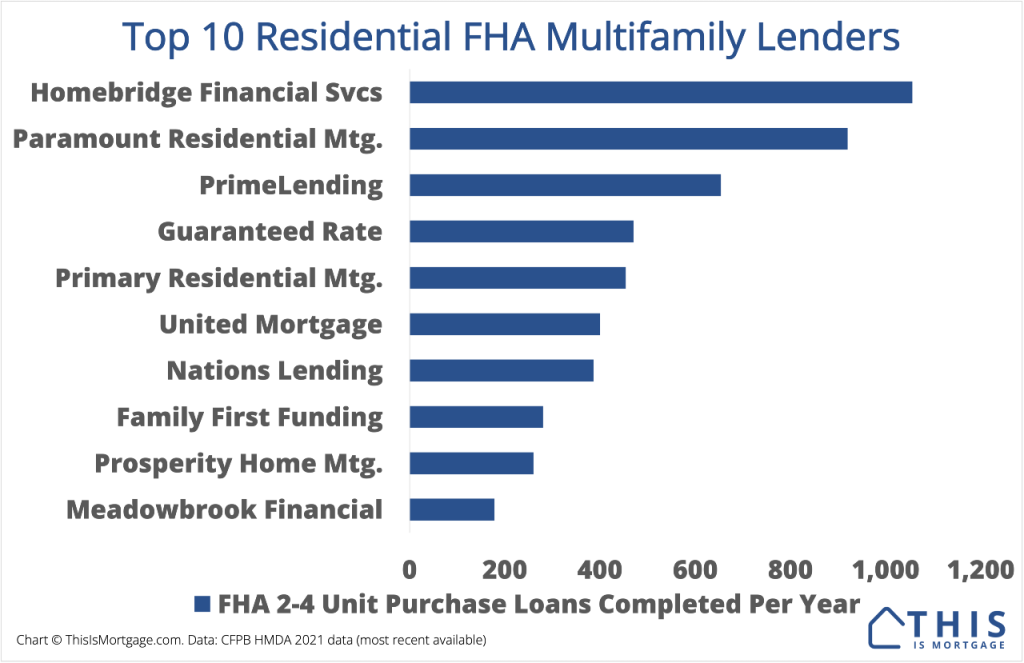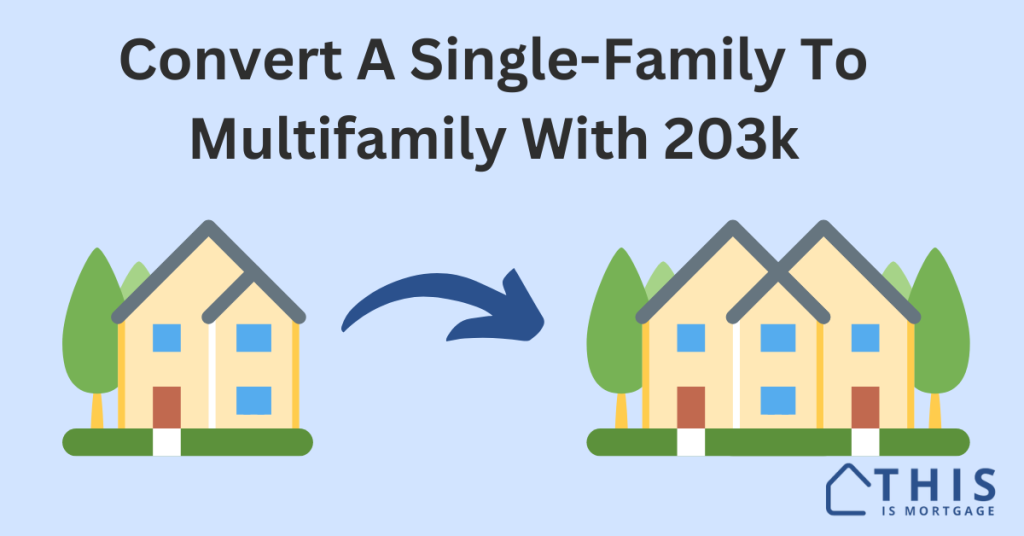If you’re looking for a multifamily property – a duplex, triplex, or fourplex – and want to use FHA, you may run into a common scenario: An ADU on the property.
FHA has an interesting rule regarding 2-, 3-, and 4-unit properties with an Accessory Dwelling Unit (ADU): The ADU must be considered another unit, not an ADU.
According to the HUD 4000.1 handbook, “For any property with two or more units, a separate additional dwelling unit must be considered as an additional unit.”
This isn’t the case with a single-family home. The property is still considered a 1-unit home even if there’s an ADU on it.
FHA’s provision for ADUs on multifamily properties can be good or bad for you as the buyer. Let’s see when it’s advantageous and when it can kill the deal.
Speak to a lender to see if you can buy a multifamily home with FHA.
In this article
- Buying a duplex or triplex with an ADU
- Buying a fourplex with an ADU
- Can an ADU on a single-family be another unit?
- How does FHA define ADU?
- Homes with more than one ADU
- Rental income on an ADU
- Multifamily home plus an ADU is a great idea
Buying a duplex or triplex with an ADU
As mentioned, duplex and triplex properties are considered one extra unit when an ADU is present.
This can be a good thing because you can add 75% of the potential rental income from the ADU to help you qualify.
For instance, you’re buying a duplex with an ADU. You’ll live in one unit. The other main unit will bring in $1,000 per month and the ADU will bring in $500. Together, you can add $1,125 per month (75% of $1,500) to your qualifying income.
However, because the property is a 3 or 4 unit in FHA’s eyes, make sure it passes the Self-Sufficiency Test.
Related: FHA 3-4 Unit Self-Sufficiency Test Calculator
Buying a fourplex with an ADU
This is where FHA’s rule can bite you. Remember that FHA says, “For any Property with two or more units, a separate additional Dwelling Unit must be considered as an additional unit.”
Say you are buying a 4-unit with FHA. But there’s a problem: an ADU on the property.
According to FHA rules, this ADU would be considered an additional unit. But FHA does not allow 5-unit homes. Anything over 4 units is considered a commercial property.
So, this deal is dead unless you want to get a commercial loan on it, which will require a much larger down payment than FHA’s 3.5%.
Unfortunately, there’s no way the appraiser is going to “look past” this ADU or forget to mention it on the appraisal. And once the lender sees the appraisal, it will kill the transaction.
Check your multifamily eligibility with a lender.
Can an ADU on a single-family property be considered another unit?
On paper, an ADU is just an ADU, but in real life, you run into a lot of gray area around ADUs.
Fortunately, as of October 2023, you can use ADU rental income to qualify for an FHA loan. This is an important change. Now, it doesn’t matter as much if an additional structure alongside a single-family residence is deemed an additional unit or an ADU. You can use rental income from either one.
However, classifying a structure as an ADU instead of a unit could affect the home’s value and zoning compliance, or cause other issues.
For instance, a 1,500-square-foot home has a detached 1,300-square-foot “ADU” on the property with similar amenities and quality of construction. Is it an ADU or another unit?
According to HUD 4000.1, “As part of the highest and best use analysis, the Appraiser must make the determination to classify the Property as a Single Family dwelling with an ADU, or a two-family dwelling.”
So a lot comes down to the highest and best use of that additional structure, according to the appraiser. It might come down to local zoning and how common ADUs are in the area versus duplexes.
Without derailing the true purpose of this post, check out Ryan Lundquist’s deep dive on whether a structure is an ADU or an additional unit.
In short, it’s risky to make an offer or order an appraisal on a single-family home with an ADU, hoping the appraiser classifies it as another unit.
Connect with a lender to see if you are eligible to buy a multifamily home.
How does FHA define “ADU”?
All of this begs the question as to what FHA considers an ADU.
In its own words, an ADU is usually, “subordinate in size, location and appearance to the primary Dwelling Unit and may or may not have separately metered utilities or separate means of ingress or egress.”
It can be created within or detached from the main unit. You can think of it as a standalone living structure where someone would not have to use amenities from the main home.
FHA says it is a “separate additional living unit, including kitchen, sleeping, and bathroom facilities.”
The problem is, a 2-unit home also has a separate residence, and sometimes those two units aren’t identical.
Again, FHA leans heavily on the appraiser to determine whether a structure is an ADU or another unit when it comes to single-family. For duplexes and triplexes, the ADU is always another unit, per FHA.
1-4 unit homes with more than one ADU
According to FHA, properties with more than one ADU are not eligible for financing.
HUD says, “The Appraiser must notify the Mortgagee of the deficiency in MPR or MPS if more than one ADU is located on the subject Property.” This seems to indicate that a property does not meet Minimum Property Requirements (MPRs) if there are two or more ADUs on it.
However, there is some gray area here, too. What if you find a duplex with two ADUs? FHA says that those ADUs should be considered two additional units, not ADUs, making it a fourplex. But at the same time, it says a property can’t have 2 ADUs.
Disclaimer: There is always a risk of a lender or appraiser interpreting things differently. However, if the appraiser can make the case that the highest and best use of the 2 ADUs is as separate units, the property might be eligible.
You should speak to the lender and an appraiser in your area about the particular property. The appraiser might say that they can’t be called additional units. Or, the lender might say they don’t want to take the risk of calling them additional units.
This is certainly a tricky situation. Be careful making an offer and ordering an appraisal on the property. But there’s always a chance it could work.
Check your scenario with a lender.
How does the lender determine rental income for an ADU?
Let’s go back to the original topic, buying a duplex or triplex with an ADU. How will rental income on the additional units, including the ADU, be determined?
Again, the appraiser has a big role.
Assuming the property is not currently rented, the appraiser will complete a market rent analysis, called a Comparable Rent Schedule or Fannie Mae Form 1004/Freddie Mac Form 1000. As the name suggests, this form tells the lender the market rent for the unit.
The appraiser will also complete an Operating Income Statement, or Fannie Mae Form 216/Freddie Mac Form 998.
The appraiser will estimate market rent of an ADU just like any other unit in the home. He or she will look at size and function and compare that with similar units in the area.
Rental income from the ADU will be less if it’s smaller or lower in quality than the units.
If the ADU is rented, you can simply supply current lease agreements to prove income.
FAQ
Yes. For duplexes and triplexes, FHA considers the ADU an additional unit, not an ADU. You can use ADU rental income to qualify.
As of October 2023, FHA allows you to use rental income from an ADU to qualify on single family residences, and 2-3 unit properties. A 4-unit with an ADU is not eligible for FHA since it’s considered a 5-unit commercial property.
Yes. FHA changed its rules in October 2023. You can now use single-family home ADU rental income to qualify even if it’s not classified as an additional unit.
Multifamily with an ADU can be a great idea
A multifamily with an ADU might be passed over by the typical buyer, but you’ve recognized an opportunity to own a home and generate rental income.
FHA provides an easy way to become a homeowner and investor with one transaction – all with just 3.5% down. And buying a multifamily home with an ADU provides additional rental income.
Do your due diligence, but buying the property could be a very good idea.




